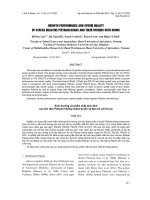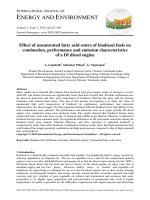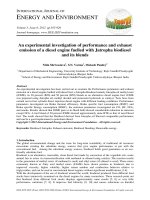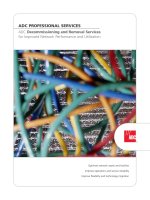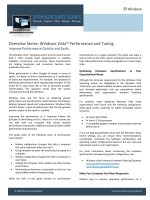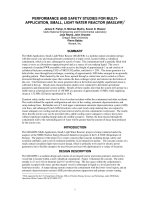Engine Performance and Driveability
Bạn đang xem bản rút gọn của tài liệu. Xem và tải ngay bản đầy đủ của tài liệu tại đây (1.28 MB, 33 trang )
by
Russell Krick
Publisher
The Goodheart-Willcox Co., Inc.
Tinley Park, Illinois
© Goodheart-Willcox Co., Inc.
Permission granted to reproduce for educational use only
© Goodheart-Willcox Co., Inc.
Permission granted to reproduce for educational use only
Locating engine performance problems
Typical performance problems
© Goodheart-Willcox Co., Inc.
Permission granted to reproduce for educational use only
Engine performance problems, often
called driveability problems, affect power,
fuel economy, emission output
levels, and dependability
© Goodheart-Willcox Co., Inc.
Permission granted to reproduce for educational use only
Strategy-Based
Diagnostics
Use a systematic approach
Question the driver or service advisor
about the symptoms and when they
occur
Look for the root cause of the failure
© Goodheart-Willcox Co., Inc.
Permission granted to reproduce for educational use only
StrategyBased
Diagnostics
© Goodheart-Willcox Co., Inc.
Permission granted to reproduce for educational use only
Diagnostic Example
An injected engine misses and emits
heavy black smoke after cold starting
Heavy black smoke = too much fuel
Only when cold = temperature related
Engine coolant temperature sensor?
ECM increases fuel when cold
Temperature-related input (ECT sensor)
may be the root cause
© Goodheart-Willcox Co., Inc.
Permission granted to reproduce for educational use only
Common Trouble
Sources
© Goodheart-Willcox Co., Inc.
Permission granted to reproduce for educational use only
Troubleshooting
Charts
If you have trouble locating an engine
performance problem, refer to a service
manual troubleshooting chart
Troubleshooting charts are based on
symptoms
Useful when no diagnostic trouble
codes are present
Suggests possible causes based on
symptoms
© Goodheart-Willcox Co., Inc.
Permission granted to reproduce for educational use only
Troubleshooting Chart
Fuel Supply System
© Goodheart-Willcox Co., Inc.
Permission granted to reproduce for educational use only
Technical Service
Bulletins
TSBs
Explain problems that frequently occur
in one make and model of vehicle
Published by manufacturers
Explain symptoms, tests, and
corrections for common problems
© Goodheart-Willcox Co., Inc.
Permission granted to reproduce for educational use only
© Goodheart-Willcox Co., Inc.
Permission granted to reproduce for educational use only
No-Crank
The starter fails to turn the crankshaft
Starting system or engine mechanical
problem
starter, solenoid, and related wiring
The starter spins but the engine does
not turn
starter drive or ring gear teeth
Mechanical problem suspected
turn the engine over manually to verify
that it turns
© Goodheart-Willcox Co., Inc.
Permission granted to reproduce for educational use only
No-Start
The engine cranks but fails to start
Check for spark while cranking
use a spark tester
Check for fuel while cranking
TBI—watch for injection
MFI—check fuel pressure and use a noid
light to check the injector wiring
Check compression
rings, valves, and valve timing are factors
© Goodheart-Willcox Co., Inc.
Permission granted to reproduce for educational use only
Check for Spark
A bright spark should jump the gap
© Goodheart-Willcox Co., Inc.
Permission granted to reproduce for educational use only
Check for Fuel
Noid light flashes, verifying ECM
control—check the fuel pressure
© Goodheart-Willcox Co., Inc.
Permission granted to reproduce for educational use only
Hard Starting
Starting may be affected by several
systems
starting motor not turning quickly enough
vacuum leaks
engine mechanical problems
incorrect fuel mixture due to a fuel
system problem
poor spark or incorrect timing due to an
ignition system problem
© Goodheart-Willcox Co., Inc.
Permission granted to reproduce for educational use only
Stalling
Engine stops running at idle, after cold
starting, or after warm-up
Causes:
low idle speed
injection system or carburetor problem
ignition system trouble
severe vacuum leaks
© Goodheart-Willcox Co., Inc.
Permission granted to reproduce for educational use only
Misfiring
One or more cylinders failing to fire
normally
at idle, under acceleration, or at cruise
Causes of misfire at idle:
fouled spark plugs or open plug wires
a cracked distributor cap or corroded
terminals
vacuum leaks
a problem with the carburetor’s idle circuit
or its adjustment
© Goodheart-Willcox Co., Inc.
Permission granted to reproduce for educational use only
OBD II Misfire Monitor
Misfires can damage the catalytic
converter
When a cylinder misses, crankshaft
acceleration will slow down slightly with
the misfire
The ECM monitors the crankshaft
position sensor for this condition
© Goodheart-Willcox Co., Inc.
Permission granted to reproduce for educational use only
Scan Tool Misfire Data
Misfire data values
Misfire history
Misfire passes
Misfire failures
Misfire rev. status
© Goodheart-Willcox Co., Inc.
Total misfires
Misfiring cylinder
RPM at misfire
Load at misfire
Permission granted to reproduce for educational use only
Rough Idle
Engine seems to vibrate
Popping noise at the tailpipe caused by
some of the cylinders not firing
normally
Causes:
vacuum leaks
lean air-fuel mixture
spark plugs and wires
© Goodheart-Willcox Co., Inc.
Permission granted to reproduce for educational use only
Engine Performance
Problems
Engine performance over time
© Goodheart-Willcox Co., Inc.
Permission granted to reproduce for educational use only
Hesitation
The engine does not accelerate
normally
Flat spot before developing power
Often a temporarily lean condition
Causes:
faulty acceleration-related components
faulty throttle position sensor
faulty accelerator pump on carbureted
systems
© Goodheart-Willcox Co., Inc.
Permission granted to reproduce for educational use only
Stumbling
Engine misses, causing jerking on
acceleration
Causes:
faulty oxygen sensor
faulty throttle position sensor
faulty engine coolant temperature sensor
intermittent electrical problems causing
loss of power to systems
© Goodheart-Willcox Co., Inc.
Permission granted to reproduce for educational use only
